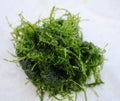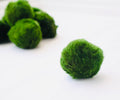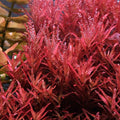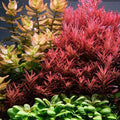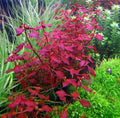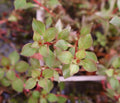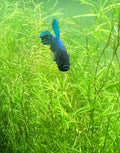All About Fissidens Moss: Fontanus vs. Nobilis
So in today's blog, we're talking about Fissidens!
Today we're talking about Fissidens—two types: Fissidens Fontanus and Fissidens Nobilis. I thought I would just do a little discussion about the difference between the two, kind of some care tactics for it, and what I think you should do with these if you ever order them and what to expect. So let’s get into it!
Fissidens Fontanus
First, let’s take a look at Fissidens Fontanus. They're a very tiny frond, but they are very, very pretty. These remind me — have you ever had a peacock feather, and the wispy end of it? How the very end of the feather strands are kind of flowy? When people wave it around, they are kind of just very wavy. So this reminds me of it underwater. That’s the kind of appearance it has. I would think of a peacock feather when you’re looking at this.
It’s a very easy-to-grow plant. This is actually a plant that is very prolific and will most likely take over your aquarium — but not in a bad way. It won’t kill other plants or suffocate them, but it will grow anywhere it can latch on to — rocks, driftwood, gravel, substrate. Anywhere there’s an open spot, it will attach.
You could literally throw this in one part of your aquarium, wait like six months, and all of a sudden you’ll see it popping up everywhere else — just because as fronds become detached, they’ll lodge themselves somewhere and start growing. Most mosses do that, but this one is extremely good at that. I find it in the weirdest spots in aquariums I’ve kept it in — it somehow finds a way.
Fissidens Nobilis
Fissidens Nobilis looks a little bit smaller, but the sheet is roughly the same size—maybe a quarter inch smaller. That’s just because the Fontanus has grown out all the way to the edges, and this one is just touching the edges.
Nobilis reminds me a lot of fern plants. If you look at the leaves or fronds here—they’re perking up, and they look like feathers too, but not like peacock feathers. They’re very cool-looking. It’s a much brighter green, whereas Fontanus is a darker green.
Fissidens Fontanus kind of hangs over. Fissidens Nobilis, which is this one, has fronds that stick straight up or at an angle, not completely curled. It looks really nice. But again, this one doesn’t grow that tall. It’s only going to be as tall as the fronds, which only get maybe a quarter of an inch tall—they’re not that tall.
Very similar to Fontanus, it will spread anywhere it gets lodged. Eventually, they’ll come loose, or a fish may graze on them and pull them out, and they’ll float somewhere else and grow. Almost identical plants—just two different looks.
Mesh Tips & Planting Advice
When you’re planting these—unless you have a specific design in mind—it’s best to keep them attached to the mesh. They’re on stainless steel mesh, which does a couple of things:
-
Keeps it anchored down
-
No need for glue or thread
-
Prevents it from floating
You can literally just plop this on a rock or driftwood. You can even bend these meshes to fit logs or curves. I recommend leaving it on the mesh because it’s easier to handle and use.
If you want, you could also cut the mesh into smaller sections. If you have metal shears (or even strong scissors), you can divide it up. I think it’s a 3x3 square, so you get a decent amount of moss. You could make little cubes if you wanted.
Growth, Trimming & Water Conditions
A couple of things with this moss:
-
It doesn’t need to be trimmed to stay short
-
It doesn’t get out of control like most mosses
-
It spreads low and flat, instead of growing tall
You’re not going to have a giant bushel of moss suddenly. It just gently covers surfaces, like rocks and wood, and grows in the crevices. No trimming required.
Availability & Final Thoughts
Fissidens Fontanus is a moss that’s been around for a while. It may be available in your local fish store pretty easily—a common moss, though still not always easy to find.
Fissidens Nobilis is more of an uncommon moss—not quite rare, but you won’t find it in most big box stores. You’d probably have to shop here at Aquafy to get it.
Personally, I prefer these over, say, Java Moss. Some people recommend Java Moss because it’s easy, but the problem is it keeps growing into a giant mess. Same with Christmas moss—you’ll need to constantly trim or groom it.
Fissidens, on the other hand, spreads naturally without becoming overwhelming. These aren’t the only two types of Fissidens. These are just the two that we readily have available, and they’re very easy to get our hands on.
You can leave your comments which one you prefer!



